It’s possible life might be found anywhere there’s salty water, even in the oceans on moons in our outer Solar System.
Nanaimo Astronomy Society’s January meeting guest speaker, Jon Willis, associate professor at University of Victoria’s department of physics and astronomy, sees a strong likelihood that Jupiter’s moon Europa and Saturn’s moon Enceladus could harbour life in their oceans.
Willis is particularly interested in astrobiology, an emerging science that focuses on the search for life beyond Earth. In 2016 he published All These Worlds Are Yours: The Scientific Search for Alien Life, a science publication by Yale University Press.
Willis also travels aboard the exploration vessel Nautilus, operated by the non-profit organization Ocean Exploration Trust, on science missions to learn what life in Earth’s oceans can suggest about life that could exist in the oceans of Europa and Enceladus.
“We know there’s salty water on both of them,” Willis said. “On Earth our salts in our oceans come from the fact that the ocean is in contact with rock. If it were sandwiched between layers of ice, perhaps, you wouldn’t get that, so the fact that there’s salty liquid water on these moons tells us, well gee, there’s water that’s in contact with rock so there’s a bottom to these oceans as well that might just look like ours.”
Europa’s ocean might be 100 kilometres deep, which on Earth would result in extreme water pressure far beyond anything found at the 11,000-metre deep Mariana Trench, the deepest point of Earth’s oceans, but Europa is smaller than Earth with about one-tenth the strength of Earth’s gravity resulting in water pressures likely no higher than those found in our oceans.
“When you see James Cameron go down to the bottom of the Mariana Trench for his documentaries, that same technology could go down to the bottom of a Europan ocean,” Willis said. “So we’ve got this salty ocean in contact with the rock. We can use our technology.”
Europa’s ocean water temperatures are also directly comparable to Earth’s. Both moons, like Earth, also have hot interiors and possibly hydrothermal vents.
“Hydrothermal vents are, basically, what you get when you mix heat with geology and we know these moons are hot on the inside. We’ve measured that,” Willis said. “Then you just apply a very good scientific principle, which is, if everything else is the same then maybe they do have hydrothermal vents … it’s that kind of similarity principle. If nothing else is different then maybe they have something similar.”
Willis admits the possibility of hydrothermal vents on those moons is just speculation, but, as he tells his students, it’s all right to speculate so long as that speculation suggests what to do next.
“You can’t just sit in your armchair and feel smug that you’ve just solved it. You’ve just speculated,” he said. “But that basically tells us, if all of that’s true then we should be able to send space missions there, somehow get through the surface ice into the ocean and go and explore on these moons. Speculation’s all right as long as it pushes you to explore.”
The problem with getting through the surface ice on Europa is that its thickness has been estimated at 10 to 30 kilometres, but Enceladus has surface geysers that spew water above the moon’s surface.
“You don’t need to drill through the ice. You just need to fly through that plume of material, scoop some up and there you go,” Willis said.
The Cassini spacecraft has flown through those plumes several times and analyzed the plume material with its mass spectrometers, which found water, salts, ammonia, methane, silica and other materials, but the spacecraft’s onboard capabilities don’t allow it to analyze for signs of life. That will have to wait for a future mission with a spacecraft equipped for that purpose.
“There are always teams proposing space missions, but there are serious advance plans for this spacecraft. It’s just NASA hasn’t funded them yet,” Willis said.
Willis’s talk follows a short presentation by society member Mark Hird-Rutter who will talk about how and why he built a backyard observatory and his experiences using it.
Nanaimo Astronomy Society’s first meeting of 2020 happens Jan. 23 at the Beban Park social centre, 7-9 p.m.
To learn more about the meeting and the Nanaimo Astronomy Society, visit www.nanaimoastronomy.com/.
photos@nanaimobulletin.com
Like us on Facebook and follow us on Twitter
